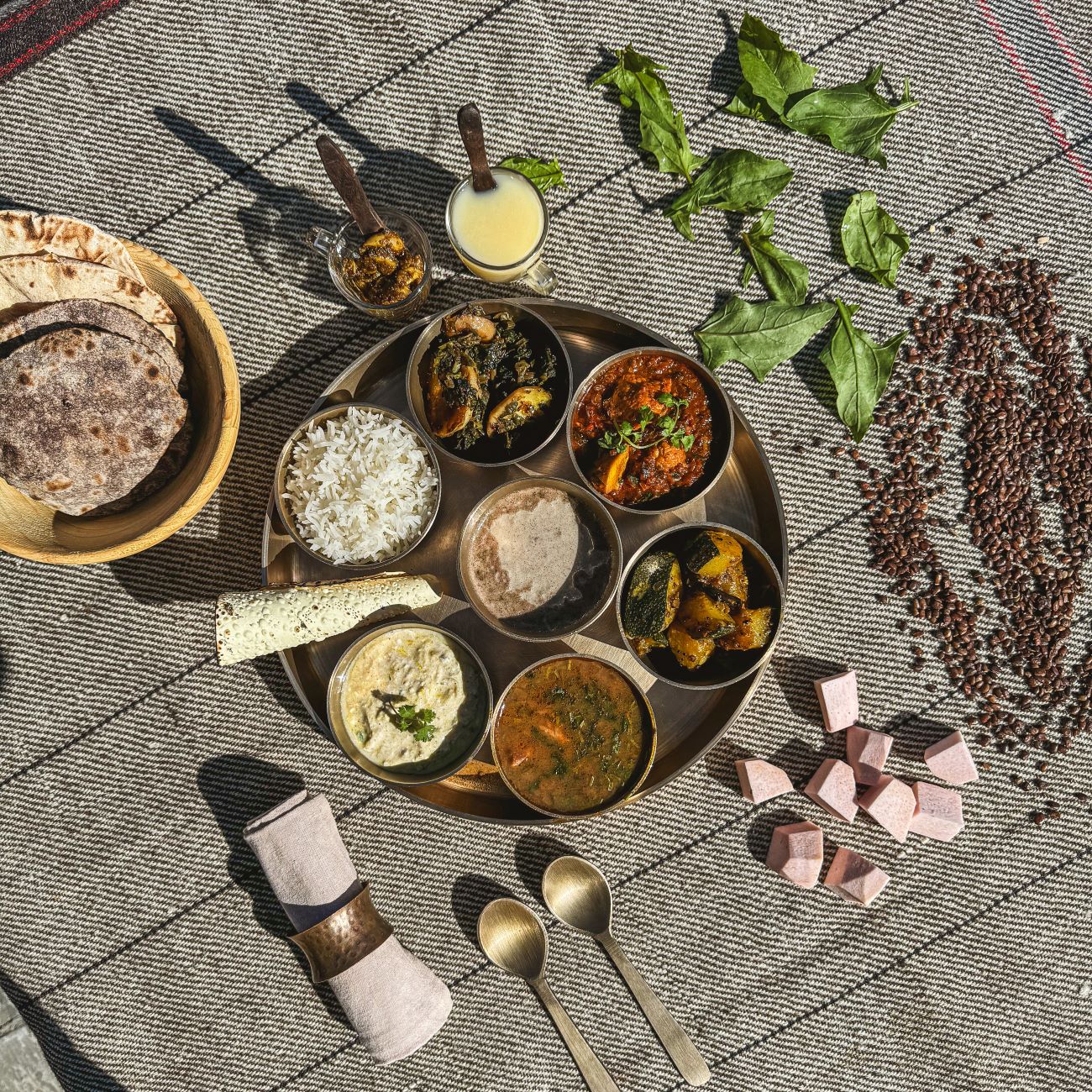Chef Naveen Adhikari tells us about what to eat and buy at the Kumaon where their culinary practices are rooted in foraging ingredients from the wild amounting to an extremely hyper-local cuisine.
Surrounded by dense oak and pinewood forests and striking mountains, Kumaon is a charming region in Uttarakhand. In recent times, it has also become a culinary destination, thanks to the craggy territory’s ancient culinary practices, hyper-local ingredients, and exquisite traditional cuisine.
We wanted to get to know Kumaoni food better (and also plan well ahead for our next visit) so we chatted with chef Naveen Adhikari of The Kumaon to find out more. Chef Naveen is the head chef at The Kumaon. With an intimate knowledge of the Kumaoni cuisine, Chef believes in curating a menu that imbibes flavours and the culinary heritage of Kumaon.
“For centuries, Kumaoni culinary practices have been rooted in locally grown produce, herbs, and grains, to create flavourful and nutritious dishes that sustain them through the region’s rugged mountainous terrain and harsh winters,” he says. “Kumaoni cuisine is characterised by simplicity and reliance on seasonal ingredients.”
These are chef Naveen’s recommendations on foods to eat and buy while in Kumaon.
Laal bhaat
Laal bhaat, or Himalayan red rice, offers a nutritious and flavourful alternative to white rice. It’s nutty, and a rich source of iron, calcium, and fibre, with a relatively lower glycemic index. It’s also known to be a superb source of magnesium, essential for bone health.
Kafuli
A mix of spinach and fenugreek leaves with local spices and rice powder, kafuli (also known as kaapa) is the state food of Uttarakhand. Packed with nutrients, it’s a dish cooked without any garlic or onions and is generally cooked in an iron kadhai. It makes a delicious accompaniment to laal bhaat.

Bhatt ki churkhani
Kaala bhatt or black soybean is abundantly grown in Uttarakhand and is a staple in Kumaoni households. It’s a substitute for yellow dal and is made as either bhatt ki churkani, or bhatt ki dal in the Kumaon and the Garwhal regions. In churkani, the lentil is first fried in oil, whereas in the dal iteration, it is soaked overnight. These black soybeans are a rich source of iron and protein.

Jhangora
Jhangora or barnyard millet is one of the oldest foods known to mankind and the most digestible grains available. It is rich in minerals and phosphorus and has a low glycemic index. Jhangora is a delicacy that serves as an important part of the Kumaoni thali in the form of jhangore ki kheer. Prepared with raisins, jhangora, milk, and kewra, this dessert is light, nutty, and nutrient-packed.
Bhang ki chutney
Bhang or hemp seeds are known for their medicinal uses and health benefits. Considered a superfood, hemp seeds are full of omega-3 and omega-6 fatty acids and are known for their antioxidant effects. The seeds aid in digestion, balancing hormones, and improving metabolism. To make the chutney, the seeds are ground to a paste along with garlic, jaggery, and green chillies. This condiment is eaten as a side dish, and also used to season vegetables. Hemp seed ‘milk’ (made by crushing, soaking, and straining the seeds) is used to prepare a warming soup with ginger, garlic, and green chillies.

Aloo ke gutke
A traditional snack or side dish from the state, aloo ke gutke is a plain old potato fry. The spuds are first marinated in spices, and after frying, topped with coriander leaves and fried red chillies. Hot and crisp, it’s an ideal snack for rainy and wintery weather.
Bal mithai
A brown chocolate-like fudge, bal mithai is a widely known and loved dessert in Uttarakhand. To make it, khoya is roasted until it reaches a fudge-like consistency, cooled, and then covered with tiny white sugar balls and roasted poppy seeds.

Chef Naveen recommends snapping up some ingredients before leaving Kumaon. Some of the region’s specialties include hemp salt, hemp seeds, red rice, Himalayan thyme, Himalayan oregano, jamboo (a tempering condiment for soups & dals), and gandrayani (an aromatic root).
The Kumaon
Situated in the heart of the Himalayas, The Kumaon offers a private and lavish mountain retreat. The hotel offers a Kumaoni thali made with seasonal produce procured from village farms and surrounding forests. Their culinary practices involve incorporating indigenous elements, macrobiotics, complex fibres, and superfoods that are native to the region. Dishes include protein-packed black soybean dal, bhang chutney made from finely grounded hemp seeds, millet flatbreads, and more.

The Kumaon also offers a nutrient-packed Kansa Thali filled with dishes from lentils and vegetables to pickles and chutneys. The Kansa metal is believed to have ayurvedic properties that can aid in digestion and enhance the flavours of the food.

